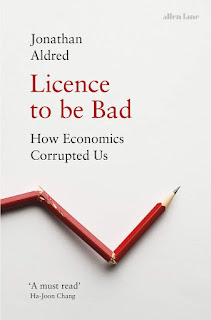Books Catch Up 4
Just 3 books today as I am finally caught up, or rather I was in October when I scheduled this post.
1. License To Be Bad
Subtitled How Economics Corrupted Us, Jonathan Aldred looks through the history of economic ideas and models and points out how the assumptions – most notably the idea of homo economicus, the man who puts a price on everything and seeks profit in every engagement – are not mere mathematical simplifications. By designing systems and signalling to people and organisations that their only concern is gain, economists have created amoral entities that destroy value in the pursuit of money.
Anyway, take a look, he’s got a good handle on the history of economic ideas and how they have been used and misused.
Read This: To learn about the development of modern economic thinking and the flaws and consequences
Don’t Read This: If you are not interested in technicalities, or if you are don’t want Aldred’s ethical and moral framework put about them
2. Sourcery
Pratchett asks the question, where does magic come from and why doesn’t it rule, and does so by having the ghost of a wizard (the eighth son of an eighth son) bring up his eighth son, trained as a weapon aimed at wizardry. Rincewind, the Disk’s worst wizard, escapes in the confusion with the Arch-Chancellor's hat to Klatch (the generic foreign country that is now forced to become a desert kingdom ruled by the Caliph Creosote, though mostly by his vizier, who was thrown out of magic school).
Anyway, some good fun bits, a yuppie genie, two different heirs to the tradition of barbarian heroism, and even the Luggage has some good bits. Look I like the Luggage but some people really like the Luggage, just have it turn up and they’re hapy, me I want it to do something, have a bit of character, and it manages in this one.
Read This: For a funny version of magic wars
Don’t Read This: Pratchett is still working through his ideas on fantasy fiction rather than turning his satirical eye elsewhere, though there’s a certain meditation on power and legacy going on
3. Six Armies In Normandy
Military historian John Keegan examines the battles of Normandy (and later elsewhere in France) of 1944 through the lens of the different armies fighting there, or perhaps he examines six armies of World War 2 through the lens of the battles of Normandy. He investigates how these armies fought in practice, which (of course) takes into account such elements as equipment, training, tactics, the weather conditions and terrain, the overwhelming allied air superiority (which had bad days, but on the whole made conditions extremely difficult for the German forces), the political situation and even, on occasion, the military theory behind it.
What I found most interesting though are the first 2 chapters, detailing firstly the journey to the second front, and then the experiences of the American paratroopers on D-Day (confusingly labelled chapter 3 in the contents of the copy I have), and the prologue, in which Keegan explains his own experience of WW2; born in 1934, his father was a schools inspector in London so when the children of the capital evacuated, his family did so as a unit. So he then spent six glorious years in the West Country while great events just barely impinged upon him. He had a quite curious view of the war that he has continually had to revise as a military historian.
The experiences of the American paratroopers were quite varied. Let me offer some selections. The hard driving SS officer whose unit spotted paratroopers set fire to a house to provide light in a pre-arranged way. Having potted quite a few Americans as they drifted down they then policed up the area and went back to bed.
Lieutenant Turnbull (described as “half-Cherokee” and so known as “Chief” to his men) with a collection of scattered troops held up a German advance for most of the day on 6th June. Short on ammunition and about to be surrounded he told his men their only choice was to charge. Others disagreed so they took a vote and decided to withdraw, under the cover of the man who suggested they fall back. As it turned out this long and not especially glorious action may have saved the position behind them in Ste Mère Eglise which was under attack from the other direction. Turnbull may never have known how this worked out as he was killed the next day by a mortar bomb.
I mentioned scattered troops; it turns out that when you pass pilots through flying school, you send the best ones to fighter and bomber squadrons, rather than to transport squadrons, where after all you only need to fly back and forth. The tricky part for planes dropping paratroopers is that you need to fly in close formation fairly low, and when they hit cloud and anti-aircraft fire, they instinctively tried to make more airspace for themselves with consequences for the troops they were dropping. (The squadrons that had worked with the units they were transporting before in Italy and Sicily did better, perhaps from experience and camaraderie, perhaps because they had had a very stern talk the last time they had been scattered over tens of miles of the landscape).
Anyway, one of the best books on WW2 I’ve read, never afraid to change scale and focus to ensure we aren’t lost, but always coming back to the important detail; men doing a job while people try to kill them.
Read This: For an overview of the battle of Normandy in exhaustive detail
Don’t Read This: If exhaustive detail sounds exhausting




Comments